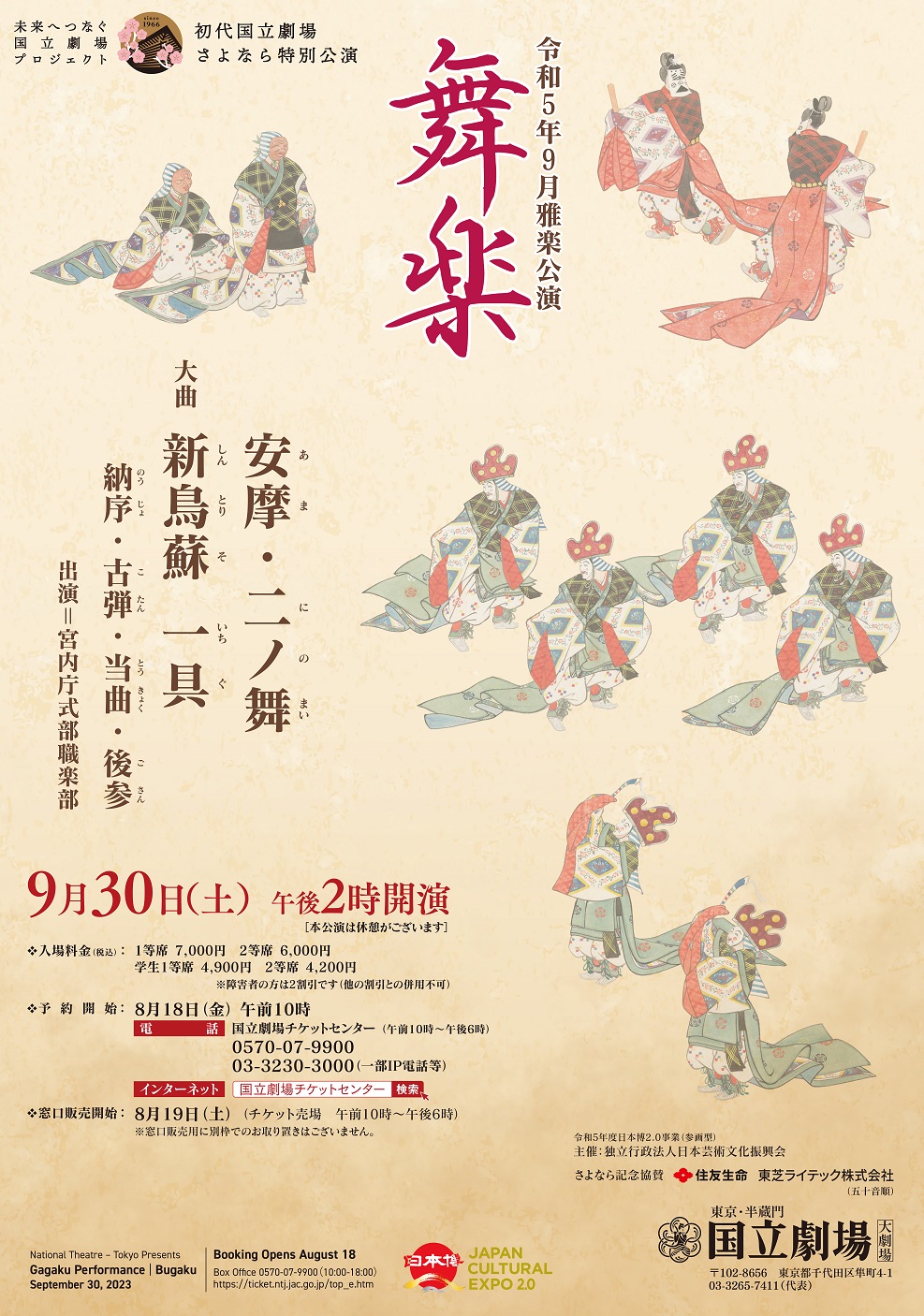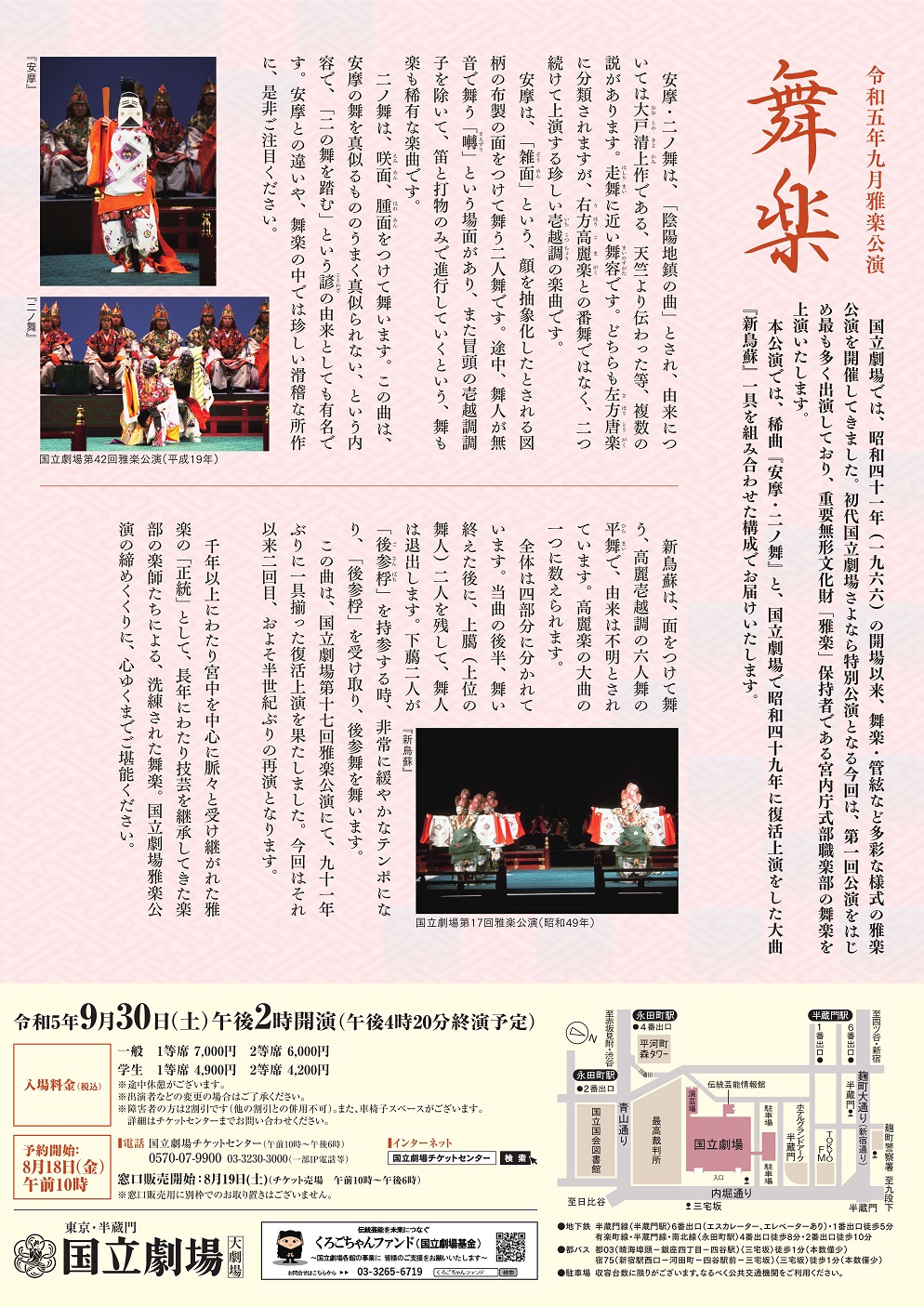- Others
- National Theatre
Gagaku Performance
National Theatre (Large Theatre)
Bugaku
Since its opening in 1966, the National Theatre has hosted a variety of Gagaku performances, such as Bugaku and Kangen. This time, as part of the National Theatre Special Farewell Performance upon the Reconstruction Project –Towards a New Adventure–, we present a Bugaku performance by the Music Department of the Imperial Household Agency. This group is a holder of the Important Intangible Cultural Property “Gagaku (Ancient Japanese Court Dance and Music)” and has appeared onstage frequently, including at our first Gagaku Performance.
This performance is a combination of the very rarely seen pieces Ama-Ninomai and Shintoriso, a large-scale piece revived at the National Theatre in 1974.
Ama-Ninomai, also known as “Inyō-jichin kyoku,” has multiple theories about its origin, such as that it was created by Ōtono Kiyokami and that it was introduced from Tiān zhū, the ancient name for India. This dance piece is similar to a hashiri-mai, or running dance. Although both are classified as Sahō Tōgaku, a style of Gagaku from China, Ama and Ninomai are two rare ichikotsu-chō pieces that are performed together, but not as a tsugai-mai (pair dance) with Uhō Komagaku, which has its origins in the Korean peninsula.
Ama is a ninin-mai (dance performed with two dancers) wearing zōmen – a cloth mask with a design considered to be an abstract human face. With the scene called “Saezuri,” in which the dancers perform in silence in the middle of the piece, this is a rare composition in terms of both dance and music, performed with the accompaniment of only a flute and uchimono (percussion for Gagaku), except for the opening which features an ichikotsu-chō mode.
Ninomai is performed with two types of masks, the emimen and haremen. This piece depicts a man and a woman having a hard time imitating an Ama dance, and this comical scene is known as the origin of the proverb “Ninomai wo fumu (make the same mistake as someone else).” We encourage you to note of the difference in this piece from Ama, and the humorous dance gestures that are rare in Bugaku.
Shintoriso is a komaichikotsu-chō hiramai in a rokunin-mai (six-person dance) with the performers wearing a mask. Its origin is unknown, and it is considered to be one of the large-scale pieces of Komagaku.
The piece is divided into four parts. In the second half, most of the dancers exit the stage after their performance, leaving the two senior dancers called jōrō. To the accompaniment of very slow-paced music, two junior dancers called gerō then appear with an implement called a gosanbachi. The two senior dancers onstage receive it to perform gosanmai.
This piece was revived and performed in 1974 for the first time in 91 years as a suite at the National Theatre’s 17th Gagaku Performance. This performance, almost a half-century later, will be the first performance since then.
Sophisticated Bugaku as presented by the Court musicians of the Music Department of the Imperial Household Agency – who have inherited their artistic skills over the years through the orthodox school of Gagaku ― these are traditional Japanese performing arts that have been passed down from generation to generation from the days of the Imperial Court for more than 1,000 years. We invite you to enjoy to your heart’s content this impressive and historic program that marks the final Gagaku performance in the original National Theatre of Tokyo.
Performance Date
September 30(Sat.), 2023
Performance Time
14:00 p.m. - 16:20 p.m.
* End time is an estimate and may vary.
Partners for Special Farewell Performances
SUMITOMO LIFE INSURANCE COMPANY
TOSHIBA LIGHTING & TECHNOLOGY CORPORATION
*Audio guide : Not available.
*Subtitles : Not available.
*English synopsis is available. Please ask at the reception desk.
*There will be an intermission.
Tickets(Tax included)
[1st Grade] Adluts: 7,000 yen (Students: 4,900 yen)
[2nd Grade] Adluts: 6,000 yen (Students: 4,200 yen)
Seating plan
Booking Opens
August 18 (Fri.), 2023
-----------------------------------------------------------------------------
Box Office
0570-07-9900 (From overseas: +81-3-3230-3000) in Japanese and English (10:00 a.m. - 6:00 p.m.)
http://ticket.ntj.jac.go.jp/top_e.htm
-----------------------------------------------------------------------------
Counter Sales at the Theatre
available from August 19 (Sat.), 2023(Business hours: 10:00 a.m. - 6:00 p.m. )


